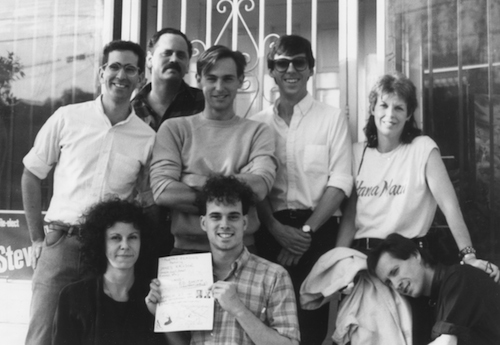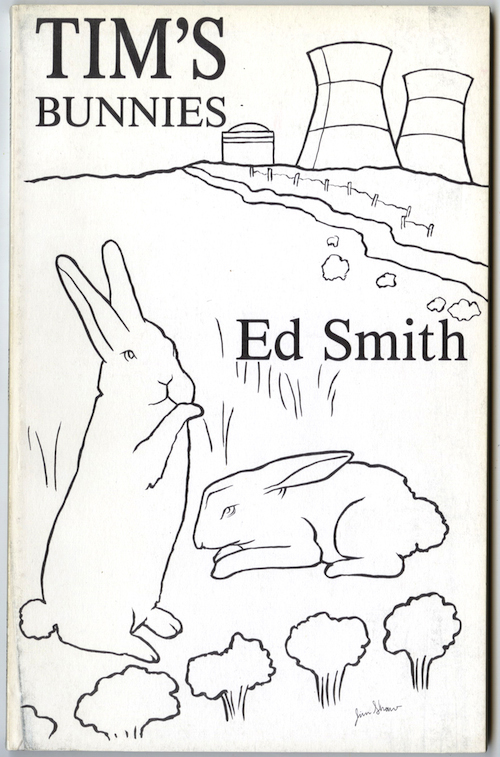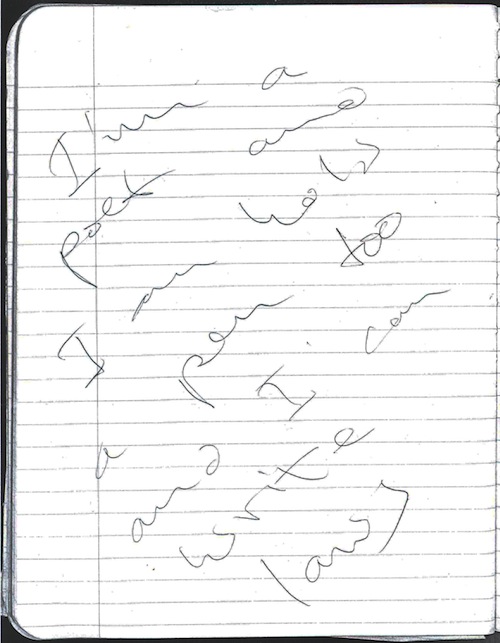Toy Time Bombs: The Poems of Ed Smith
I’d like to use this opportunity as Featured Blogger to introduce you to a poet you’ve never heard of before. Ed Smith. A common enough name. There are a zillion Ed Smiths on Facebook—I gave up counting them once I reached one hundred. But this Ed Smith was no ordinary Ed Smith, let me assure you. He was born in Queens, New York, in 1957; his family moved to Southern California in 1959. He grew up in Downey (the hometown of Richard and Karen Carpenter) and attended Pomona College in Claremont for one academic year (1975-76). He then made his way to Los Angeles, Hollywood specifically, where he worked as a paralegal and for an independent record and video company, became involved in the punk rock lifestyle, then finally found his niche as a poet in the scene that centered around Beyond Baroque Literary/Arts Center in Venice, California, when Dennis Cooper ran the reading series there in the early eighties. The Beyond Baroque scene has sometimes been called “hip,” sometimes “infamous.” It was lively, that’s for sure. Other young poets who gravitated to the literary liveliness were Amy Gerstler, Bob Flanagan, Jack Skelley, and myself.

Ed published two books of poetry in his lifetime, both with Cold Calm Press: Fantasyworld in 1983 and Tim’s Bunnies in 1988. You’ll probably have trouble finding either of these titles—Cold Calm Press was a very small operation. Ed also published his work in Poetry Loves Poetry: An Anthology of Los Angeles Poets (Momentum Press, 1985) and in what Bruce Hainley calls "the most rambunctious publications of the day: Barney, Mirage, Santa Monica Review, and Shiny International [later just Shiny], a magazine for which he conducted interviews with artists Jim Isermann, Mike Kelley, and Chris Burden and eventually served as West Coast editor.” Publishing poems in rambunctious magazines does not pay the rent, so Ed worked as a typesetter, a movie ad copywriter, and a math tutor at a private school. He moved to New York City in the late nineties, married artist Mio Shirai, and founded Creative Systems Architecture, Inc. (CSAI), a consulting firm meant to help companies apply W. Edwards Deming’s principles of emergent intelligence to their organizations. (Sounds crackpot, but there’s something to it.) Sadly, Ed took his own life in 2005.
At first I didn’t care for Ed. I mistook his irreverence for disrespect. And maybe there was some jealousy. He was slightly younger than the rest of us in the Beyond Baroque group, cute (almost everyone was infatuated with him at some point), and punkish (he had, after all, come of age in the punk rock scene). I thought he could be obnoxious, a brat. But after I got sober (in 1984) and calmed down a bit (I’d been an uptight alcoholic, which kind of defeats the purpose), I became quite fond of him. Underneath the brash exterior was a very sweet, guileless young man. Amy Gerstler, who knew Ed much better than I did, has said this of him:
Ed Smith was this brilliant, handsome, charismatic, disarming, hedonistic, wounded math and science nerd who discovered punk music and art and poetry and was swept away, besotted with all three, and never looked back. He loved drugs and bands and science fiction and science and Sappho and poets and poetry. He liked to give people a little treatise by Alfred North Whitehead on mathematics for a gift. He loved being part of a cool scene. He introduced me to Prince’s music when his first album came out. I think he would have described himself as bi-sexual. He was intense and sensitive and wild. He burned hotly.

My two tenderest memories of Ed are from 1988. On October 30, we were both at a poetry reading at Beyond Baroque. Bored with one of the readers, I slipped out to smoke a cigarette in the lobby. Ed, I discovered, had done the same. We sat on the floor and smoked and whispered together, truants in cahoots, and ended up writing this little collaboration:
half
beautifuldon’t
swaypoint
north
An obvious call-and-response, I no longer remember which words are Ed’s and which are mine. I still have a typed copy of it, signed by both of us. It occurs to me, as I look at it a quarter of a century later (words faded, paper yellowing), that it is incorrectly dated: “10/30/88.” Because I moved to New York in July of 1988, this could not have taken place that year. Did it happen the year before, 1987? Or the year before that, 1986? Or even earlier? A curious little mystery about a moment in our lives that we were compelled to commemorate with the wisp of a collaboration.
My other tender memory: when Ed was putting together his second book of poems, Tim’s Bunnies, Amy suggested he seek my advice about selection and order. Ed called me, and we made a date. He came to my studio apartment in Silver Lake, I brewed a pot of tea, and we spent a lovely afternoon reading and talking about his poems. I can’t see Ed’s face for some reason, but I can see his poems spread out all over the gold shag carpet (Harvest Gold—very seventies). As a result, he thanked me in the book. I was touched by that. I am still touched by that.

And what of his poems? Ed’s poetry was exactly like he was: playful, free of inhibition and decorum, troubling in just the right way. And wrought with intelligence, brilliance even, though on the surface they may seem apathetic to loftier poetic aims. He wrote “Return to Lesbos” (most likely his longest poem) in a black-and-white composition book, scrawling the whole poem throughout it, often with only two, three, four words per page. Ed apparently never typed or tried to publish it. He read the poem at least once to my knowledge, at Beyond Baroque in 1982. Lucky for us this performance (which Amy remembers as a sublime consummation of Ed’s talent as a poet and performer) was filmed and included in Gail Kaszynski’s 1983 documentary about the Beyond Baroque scene, Fear of Poetry. It’s breathtaking to watch Ed stand at the mike, wearing a short-sleeved nerdish shirt he undoubtedly bought at a thrift shop, and read the poem from the composition book, swiftly turning its pages. He simply gallops through the poem, as if he’s uncomfortable with what it’s saying. Fitting, since “Return to Lesbos” is an emotionally charged onrush in which he repeatedly questions his responsibility as a poet: is he going to just hold that “fucking pencil” or use it to “cry for civilization.”

Ed is at his best in his short lyrics. They have the sense that they were jotted down on scraps of paper while waiting at a bus stop or standing in a club nursing a beer he’d bought with his last bits of loose change. They probably were. I’ve always thought of Ed as a punk Dorothy Parker. Bruce Hainley refers to Ed’s poems as “toy time bombs.” I think that’s perfect. Something does tend to “go off” as you read them. They delight and cause unease at the same time—they’re authentic, that’s why. There’s real pain and real experience in them, despite their apparent toy-ness. Here are three examples:
DENIAL
I would never do this.
This isn’t me.
You’d never catch me being words on paper,
Being written down,
Being in a position where
I could always be come back to and read.
FISHING
This is a good line.
This is a bad line.
This is a fishing line.
PLEASE
Please repress me
Please do your best to break my spirit
Please judge me
Please grade me
Please reward me and please punish me
Please teach me right from wrong
Please make me feel unimportant
Please make a mockery of my existence
There are a lot of untitled one- and two-liners, too. “if this were a bomb / you’d be dead” was probably funnier before the Boston Marathon bombings. But even before the bombings, the poem was funny and scary. Now it’s funny and scarier. Ed’s poems are perfect for our ADD, technology-distracted times; his lines are eminently tweetable. Take your pick: “I love it when you’re wrong”; “bait and switch”; “I spent a few minutes / looking for a lightbulb”; “shiver yer own / goddam timbers”; “this morning I dreamed / I threw myself from a / car you were driving.”
Last year, Hainley edited a generous selection of Ed’s poems for Court Green (issue 10), a journal I co-edit at Columbia College Chicago. The feature was called, appropriately enough, “Memoirs of a Thrill-Seeker.” This year, in Court Green 11, we published a transcription of “Return to Lesbos.” At the publication party in March, we showed a clip of Ed reading the poem. The audience went wild. “Where can I find his work?” many in attendance eagerly asked. Students, in particular, showed irrepressible excitement. Young people love Ed; his work speaks to them, it’s pertinent. Amy Gerstler and I have been talking about co-editing a book of Ed’s work. I think this would please him—his poems gathered up by two poet friends he hung out with. I’m glad we can continue to hang out with him, and that you’ll be able to, too, since he let himself get caught “being words on paper.”
David Trinidad is the author of more than a dozen books, including Peyton Place: A Haiku Soap Opera ...
Read Full Biography

